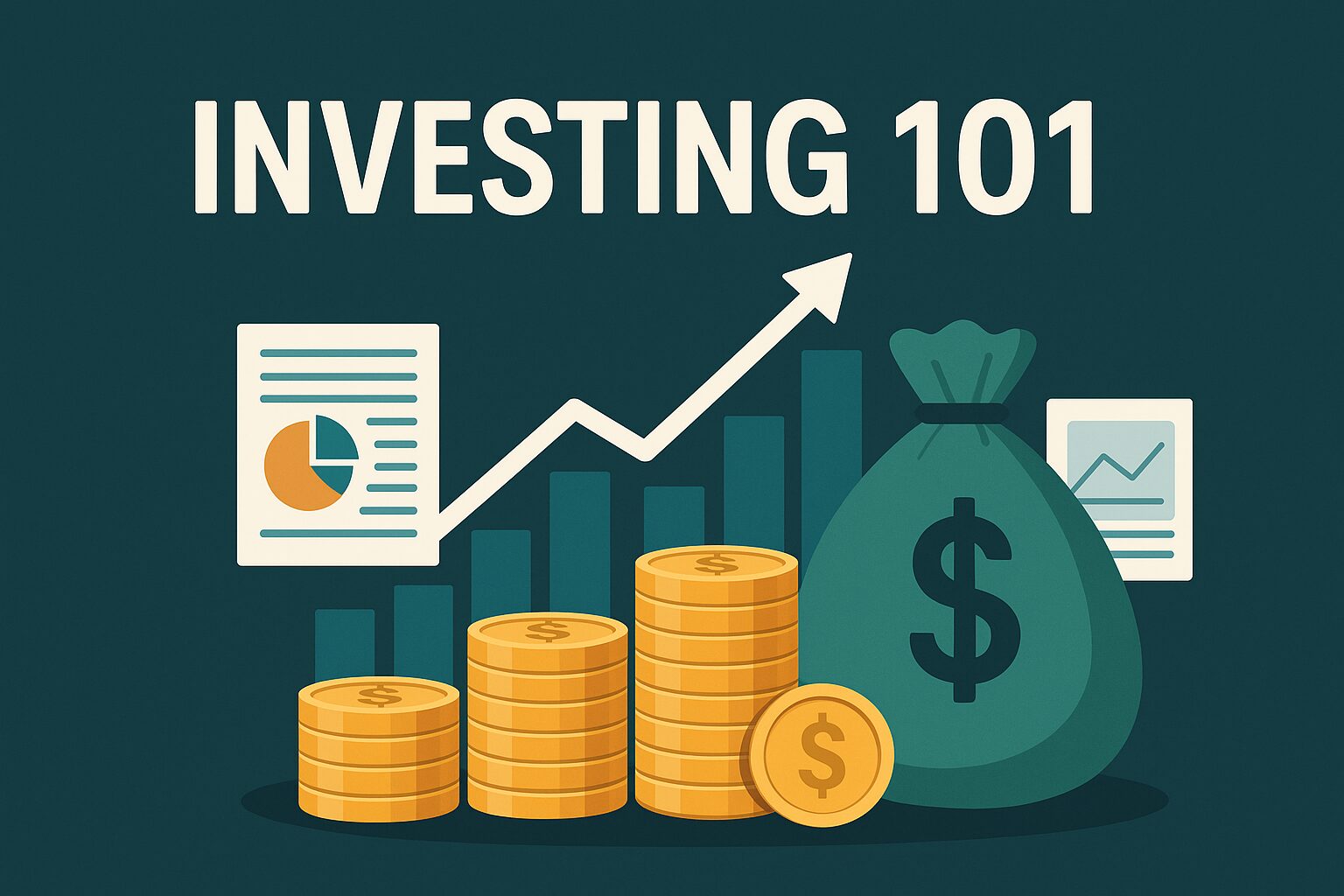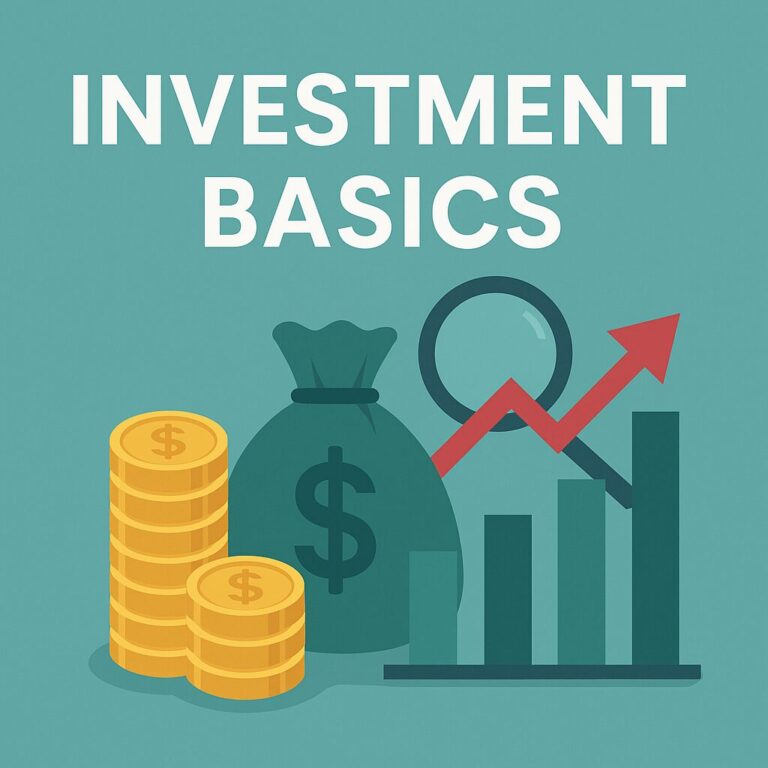Investing 101: A Beginner’s Guide to Growing Wealth
When most people think about investing, they imagine Wall Street traders shouting orders on the stock exchange floor or wealthy individuals with private financial advisors. The truth is, investing isn’t just for the rich. It’s for anyone who wants to build wealth, protect their financial future, and make their money work harder than they do.
But here’s the catch: many beginners feel overwhelmed. The jargon, the risk, and the sheer number of options—stocks, bonds, ETFs, real estate, and retirement accounts—make it seem intimidating. This guide breaks down the essentials in plain language. You’ll understand the “why” behind investing, the basic strategies, and how to get started even if you don’t have a lot of money.
If you’ve ever thought, “I should invest, but I don’t know where to start,” this article is for you.
Why Investing Matters
There’s a reason personal finance experts always stress the importance of investing: it’s the foundation of wealth building. Saving is important, but savings alone won’t beat inflation. A dollar today won’t have the same purchasing power 20 years from now. Investing allows your money to grow faster than inflation, helping you reach goals like retirement, buying a home, or leaving a legacy for your family.
Think of investing as planting seeds. The earlier you plant them, the more time they have to grow into a forest. Time is your biggest ally in investing because of compound growth—when your earnings start generating their own earnings.
For example: if you invest $200 a month starting at age 25, with an average 8% return, you’ll have around $600,000 by age 65. If you wait until 35 to start, that number drops to about $270,000—even though you contributed just $24,000 less. The difference isn’t how much you invest. It’s how long your money has to compound. Put away $18,000 at 18, and you could be a millionaire at retirement (assuming steady market growth). That’s the power of compounding interest.
To see the magic for yourself, plug your numbers into this compound interest calculator.
—>But before you can consistently invest, focus on getting out of debt so your money can start working for you instead of lenders.
Before You Invest: Learn the Ancient Laws of Wealth
Modern investing tools may change, but the laws of wealth haven’t.
George S. Clason’s The Richest Man in Babylon teaches the foundation every investor needs:
save first, control your spending, guard your capital, and let your money multiply through patience and wisdom.
It’s the perfect bridge between disciplined budgeting and confident investing — because wealth isn’t built in the market; it’s built in the mindset.
Read our full book report: The Richest Man in Babylon – Timeless Rules of Wealth and Prosperity
Common Myths About Investing
Before diving into the mechanics, let’s bust a few myths that hold people back.
“I need a lot of money to start.” Not true. Today, you can begin investing with as little as $10 using platforms like Acorns, Robinhood, or M1 Finance. Even $100 a month invested into an S&P 500 index fund from age 25 could most likely make you a millionaire by retirement, thanks to compounding. Historically, the stock market has delivered about 8%–10% per year, based on the average annual returns of the S&P 500.
“Investing is gambling.” Gambling is pure chance. Investing, when done wisely, is about long-term ownership of assets that tend to increase in value. Yes, there are risks, but they can be managed with a diversified portfolio. Mutual funds, index funds, or ETFs provide built-in diversification, and for risk-averse investors, adding a bond fund or two can balance volatility.
“I need to be an expert.” You don’t need a finance degree. With index funds and robo-advisors, you can automate your investments and often outperform most active traders. Index funds are maintained by computer algorithms that balance portfolios to match their benchmark. Meanwhile, mutual fund managers try to beat the index—and lose about 80% of the time.
“The stock market is too risky.” In the short term, markets fluctuate. Over decades, however, the stock market has consistently outperformed other assets. The key is time, diversification, and dollar-cost averaging—investing the same amount regularly regardless of market conditions.
—>Overcoming those myths starts with building a money mindset that sees investing as opportunity, not fear.
One of the best introductions to this shift in thinking comes from Robert Kiyosaki’s classic, Rich Dad Poor Dad.
It contrasts two worldviews — one that works for money, and one that makes money work for you — and shows how understanding the difference between assets and liabilities changes everything about investing.
If you’ve ever wondered what separates the rich mindset from the paycheck mindset, that book is a must-read before diving deeper into this pillar.
->Here is an article that covers the basics of investing. If you follow these guidelines, you will have a small fortune when you get to retirement age.
Understanding Investment Basics
Risk vs. Reward
Every investment carries risk. Generally, the higher the potential return, the higher the risk. Stocks can grow quickly but are volatile. Bonds are more stable but provide lower returns. The trick is balancing risk and reward based on your goals and comfort level.
Asset Classes
Investments fall into categories known as asset classes:
- Stocks (Equities): Ownership in a company. High growth potential, higher volatility.
- Bonds (Fixed Income): Loans to governments or corporations. Lower risk, steady returns.
- Real Estate: Physical property or real estate investment trusts (REITs). Provides diversification and passive income.
- Cash Equivalents: Money market accounts, CDs. Safe but low return.
- Alternatives: Commodities, crypto, private equity. Higher risk, speculative.
Diversification
Don’t put all your eggs in one basket. Diversifying across assets reduces risk. If one investment performs poorly, others can balance it out. A smart strategy some investors use is tax-loss harvesting—selling underperforming investments at year’s end to offset taxable gains. It’s a way to let diversification work not only for stability but also for tax efficiency.
Step 1: Define Your Investment Goals
Investing without a goal is like setting out on a road trip without a destination. Ask yourself: am I investing for retirement? Do I want to buy a house in 10 years? Am I building generational wealth?
Each goal influences your strategy. Retirement investing leans long-term and aggressive (more stocks). Shorter-term goals require safer investments like bonds or cash equivalents.
Step 2: Understand Retirement Accounts
Retirement accounts are the easiest way for most people to invest because of tax advantages.
Employer-Sponsored Plans
- 401(k)/403(b): Contributions are pre-tax, reducing taxable income. Many employers match contributions—always take the match.
- Roth 401(k)/403(b): Contributions are after-tax, but withdrawals in retirement are tax-free.
Individual Retirement Accounts (IRAs)
- Traditional IRA: Contributions may be tax-deductible. Taxes are paid upon withdrawal.
- Roth IRA: Contributions are after-tax, but withdrawals in retirement are tax-free.
These vehicles allow your investments to grow tax-deferred (Traditional) or tax-free (Roth), compounding faster than taxable accounts. For more details, the IRS provides a guide to different retirement accounts explained.
Step 3: Choose Your Investment Strategy
Passive Investing is the “set it and forget it” approach. Broad market index funds and ETFs let you ride market growth over time. Research consistently shows passive investing beats most active traders.
Active Investing involves picking individual stocks or timing the market. It requires time and skill, but 80% of stock pickers underperform the market each year. Even those who outperform one year often fall back the next.
Want to compare your options? Here’s a breakdown of index funds vs mutual funds.
Robo-Advisors like Betterment and Wealthfront automatically create and rebalance diversified portfolios for you. They’re a great beginner option, though I encourage getting hands-on experience to truly learn.
Step 4: Know Your Risk Tolerance
Risk tolerance depends on age, finances, and personality. Younger investors can afford more risk because they have decades to recover from downturns. Older investors may prioritize stability through bonds and dividend-paying stocks.
A common guideline is the 110 Rule: subtract your age from 110 to find the percentage of your portfolio in stocks. A 30-year-old might aim for 80% stocks and 20% bonds.
A helpful chart from Fidelity shows recommended asset allocation by age..
Step 5: Build Your Portfolio
Beginner portfolios don’t need to be complicated. In fact, simplicity wins.
Example starter portfolio:
- 80% Total Stock Market Index Fund (including international exposure)
- 20% Bond Index Fund
As you grow, you can add REITs, dividend stocks, or international bonds for additional diversification.
Step 6: Stay Consistent with Contributions
The real secret weapon of successful investors is consistency. Regular contributions matter more than timing the market. Even in downturns, keep investing—it’s like buying stocks on sale. Automate transfers to your investment account every month. Over time, the habit builds serious wealth.
—>Consistency is easier when you already have a budget that actually works and frees up money for investments.
Step 7: Avoid Common Mistakes
Here are rookie mistakes to avoid if you want to grow a sizable portfolio:
- Timing the Market: Nobody can consistently predict highs and lows. Focus on time in the market.
- Emotional Decisions: Fear and greed drive poor choices. Stick to your plan.
- Neglecting Fees: High fees eat into returns. Choose low-cost index funds and ETFs.
- Ignoring Taxes: Understand capital gains tax and invest tax-efficiently.
Real-World Example: Two Friends, Two Outcomes
Alex and Jordan both start working at 25. Alex invests $300/month immediately. Jordan waits until 35 but invests $500/month.
By 65 (assuming 8% returns):
- Alex has about $1.3 million.
- Jordan has about $750,000.
Even though Jordan contributed more each month, Alex’s early start gave compounding more time to work its magic. The lesson? Time is your biggest asset. The best time to start was yesterday. The next best time is right now.
💡 Recommended Reading: The Little Book of Common Sense Investing by John C. Bogle — A timeless guide to building wealth the simple way through low-cost index funds and long-term discipline.
Step 8: Keep Learning and Adjusting
Markets evolve and so does your life. Review your portfolio annually. Rebalance if one asset class grows too large. Adjust risk as you get closer to retirement. Stay informed but don’t let daily headlines distract you from your plan.
Advanced Paths for the Future
Once you’ve mastered the basics, you might explore advanced strategies:
- Dividend Investing: Building income streams through dividend-paying stocks.
- Real Estate Investing: Rental properties or crowdfunding. But take care—without enough financial cushion, one bad tenant can create a financial mess.
- Options and Futures: High-risk derivatives that can magnify gains—or losses. These are not for beginners. A bad bet here can leave you owing money to your broker.
- Cryptocurrency: Highly speculative, but some allocate a small percentage here.
Don’t touch advanced strategies until your foundation is rock solid.
Final Thoughts
Investing isn’t about getting rich quick. It’s about building wealth steadily over time so you can create freedom and choices in your life. The earlier you start, the more compounding works in your favor.
Don’t let fear or lack of knowledge hold you back. Start small, stay consistent, and stick with simple, proven strategies. Whether through retirement accounts, index funds, or a robo-advisor, your future self will thank you for planting seeds today.
The ultimate reward of investing is the ability to align your lifestyle with your financial goals instead of being stuck living paycheck to paycheck.
Wealth isn’t built by chance—it’s built by choice. And the best time to start making that choice is right now.
I’d like to hear from you. If you’re beginning your investment journey, at what age are you starting, and are you using an employer-sponsored plan or a discount brokerage like Vanguard, Fidelity, or Schwab? Let me know—I always respond back.



